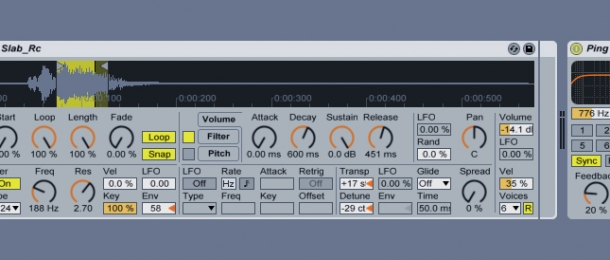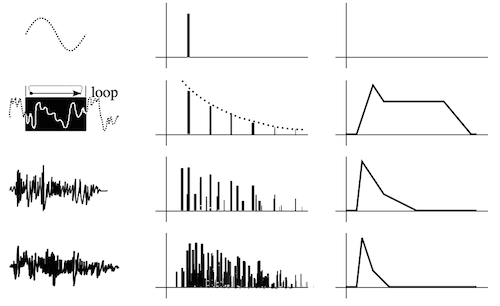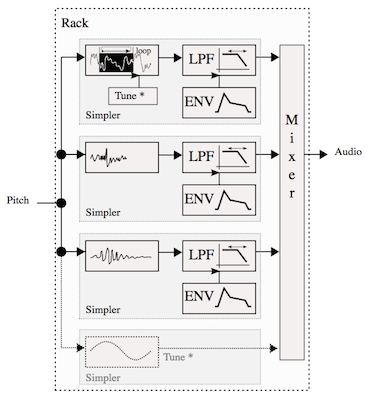
Recently, ModeAudio ran a competition with the excellent folks over at AudioNewsRoom to offer you the chance to win a copy of our Found Percussion Bundle. As chance would have it, one of the winners was none other than Martin Russ, sound designer, blogger, all-round music tech guru and author of the brilliantly exhaustive Sound Synthesis & Sampling book published by Focal Press! I remember reading it late into the night when I was a teenager, devouring ever-more complex and fascinating diagrams of overtones and sonograms with each passing minute - heartily recommended reading for anyone with even a passing interest in how electronic sound works.
So, with a direct connection between our sounds and such a cultured musical mind now established, it seemed almost criminal not to take the opportunity to get some analytical feedback - needless to say, as well we might have expected, the results of our Q&A session pushed well beyond the bounds of analysis and into stunningly creative territory, thanks to Martin's ingenious tinkerings with our samples. I'll pass the mic over to him and very much hope you enjoy part 1 of his exploration into our Found Percussion Bundle!
1. Unpicking 'Fracture'
ModeAudio (MA). Firstly, congratulations on winning the competition!
Martin Russ (MR). Thanks! I enjoyed playing with the packs...and I've only just started!
MA. We're absolutely delighted that you've decided to share your exploration of the Found Percussion Bundle with us. You've produced a number of example sounds using creative manipulations of the included samples - let's begin with your Fracture example. The soundscape that you produced sounds vaguely familiar - why is that?
MR. When I went to the BBC Radiophonic Workshop I was struck by how they had an eclectic mixture of old and new, high-tech and low-tech, and that these applied to instruments, techniques and people. Tape manipulation is one of those techniques, and so I've always liked doing unspeakable things to samples via frequency shifting and transposition. Parallel playback of the same sample at different transpositions can sound very big and imposing when you are a long way from the root pitch, and with percussion sounds you can modulate the transposition without it being too obvious.

So the 'Space' sound is three parallel samples from Fracture, transposed differently, and with a pitch envelope to provide the movement. The underlying sample is a nice abstract grating sound, but lots of other samples work well with this type of treatment, and it harks back to using a variable speed tape recorder on a tape loop. As a result, some of the characteristics of playback, like the way that pitch and tempo are linked, are built into some classic sound effects from the past, and that's why your head thinks it sounds vaguely familiar. Recreating this type of effect in a modern context can be much faster, and considerably easier, than it was for the pioneers of electronic music.
2. Going 'Undercover'
MA. The Undercover soundscape is very different - it puts you inside a cave!
MR. The patch is approximately the same for both. It is just a Rack with several Simpler sample players in it, and using Envelopes as LFOs to modulate pitch, filters, pan position, etc. But the source of the sound is very different. I felt that I ought to do something percussive, but not drums, and so a sound effect seemed like a good idea. One of the intriguing things about movie sound design is that the sound stage often doesn't move about as much as the visuals suggest it should, and if you do try moving audio around too much, then it can become very disorienting. So I made a special effect 'cave' soundscape where there's a lot of movement, and you can imagine it being used sparingly to deliberately unsettle the audience.

MA. It looks like you're using Simpler in an interesting way from your Ableton Live screenshot - any tips and tricks to share there?
MR. The samples are short percussive impulses, with the envelopes tweaked to make them shorter, and then put into one of those BIG reverb environments that you get to use very rarely! Using unlinked looped envelopes with different lengths provides lots of sound effect for little effort, and without obvious repeats. I've done music where the parts have bar lengths that are prime numbers, i.e. 2,3,5 7,9,11,13, and you get long sequences before it repeats. With envelopes you can work with fractions of bars, and so the length of the sequence can be very long indeed.
3. Cacophonous 'Klang'
MA. You did something strange and unexpected with a sound from Klang, didn't you?
MR. Well, the bundle was percussion-oriented, so I decided that I'd try and go in exactly the opposite direction and make a synth sound. I have always been interested in sounds that are not emulations of real sounds, nor are they obviously synthetic, but instead they occupy that region that lies somewhere in between. Samples that are intended for use as drum or percussion sounds are good for this because they tend to have unusual content, and that makes them interesting.
The basic idea behind the sound I produced is to use several different sounds to give a composite result that sounds like a single unknown tuned instrument. The pitched part is just a looped section of a drum sample, where the transposition and fine tuning have been set so that the loop is tuned to the right pitch. I used a mix of my ears and a simple sine wave sample to provide a tuning reference so that I could get it in tune, but in Ableton 9.2 you could also use the Tuner effect.

MA. The result is very interesting and sonically unusual. In fact, it no longer really sounds like something sampled from the real world but more like something electronic and synthesised!
MR. One of the differences between a synthesised sound and a real world sound is the spectrum. Additive, subtractive and wavetable synths all tend to produce waveforms that are made up of a fundamental and harmonics, and it can be rather too mathematically perfect, even if you add noise (a trick I learned many years ago from Vic Emerson of Sad Cafe as a way to brighten string sounds). Real world sounds aren't quite as well behaved, and techniques like FM provide one way to fill in the gaps between those harmonics, but that doesn't mean that they are easy to understand. So one way of cheating is to use a percussive sound as the source of extra frequencies, and that's what the two other layers in the sound do.
So we have a looped percussion sound as the sustained part of the sound, and two layers of shorter percussion samples as the attack part. It has a metallic, glassy feel, and because the sample attacks are pitched, you get a sense of different physical sizes associated with the different notes, whilst the sustained notes make your ear wonder if it might be bowed rather than struck. Two attacks means that you can transpose the samples so you have a broader range to work with, although it is hard to avoid the impression that there are several different instruments - and the techniques to do that are something I've been working on for a long time now. Using multiple samples to produce one sound also provides lots of material to work with when putting velocity sensitivity into a sound, and this can turn an interesting novelty into an expressive instrument, although it can take a lot of time. When I programmed FM sounds, I spent most of the time adjusting the velocity sensitivity (and then the key scaling, with basic tones being the fastest bit).

MA. You've also produced a diagram to show the circuit and signal flow used to produce the Klang example - what's going on here?
MR. The diagram shows one of my characteristic weaknesses - I tend to use filters instead of VCAs to shape sounds. So each portion of the sound has a filter driven by an envelope, so that the brightness of the sound can vary with time (and with velocity!). Too much resonance on a VCF can make the overall sound too much like a synthesiser, but then when you have a tuned percussion sound that sounds kind of weirdly real, then the contrast can be quite startling, and I like surprising sounds.
MA. Do you have any further advice regarding using the samples in a more personal and unique way?
MR. One of the problems of buying ready-made sounds is that it is very easy to get the same sounds as everyone else. But there is nothing to stop you mis-using ready-made sounds! Using percussion samples as the basis for synth sounds is a good way to ensure that you can sound different. A few layers of a basic sample player like Simpler in a Rack provides a good starting point, and if you have the processing power, then layers of Sampler give more options to play with. Don't be afraid of extreme transposing of samples, because this can be a very fertile source of sounds - try transposing a sample of an orchestral triangle! You will find that at the home pitch it sounds like a triangle, and for any other transposition it isn't a triangle!
I'd just like to thank Martin Russ for sharing such interesting tips and insights into his creative process - keep an eye on ModeAudio Magazine for the concluding part of his exploration into our Found Percussion Bundle!













